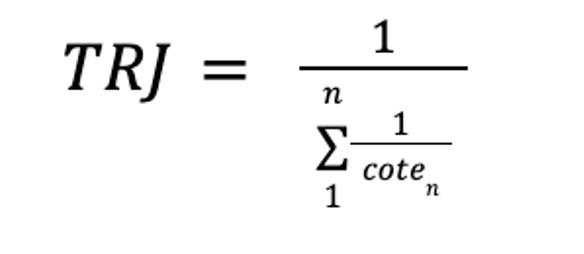
In the first part of his series on sports betting, Olivier Kaplan narrated the evolution of the product from 1X2 grids to early fixed-odds betting offers.
In Part-2 of his analysis, Olivier explains how operators have been able to expand their offerings by putting in place the tools and user experience (UX) that enable players to make full use of them.
RTP, odds and probabilities
First of all, a quick mathematical reminder to understand how odds and margins work:
- Let’s take the 1X2 odds for a Spanish Primera Liga match: 2.65 / 3.58 / 2.48.
- From these three odds, we can deduce two things: The pay out ratio or return to player (RTP) and the probabilities corresponding to each of the odds.
Calculating the RTP
Assuming that the RTP is applied in linear fashion between all the choices for a given type of bet, despite potentially significant differences in the odds between the selections (TRJ = RTP, cote = odds):
In this example, we get a pay out ratio of: 1 / [(1 / 2,65) + (1 / 3,58) + (1 / 2,48)] = 94,35%.
We can then deduce the theoretical probabilities for each choice by the following equation:
So with a RTP of 94.35% divided by odds of 2.65, probability is: 0,9435 / 2,65 = 35,60%.
By applying the same formula to the other two selections of the bet, we obtain probabilities of 35.60%, 26.36% and 38.04%. The fact that the sum of the probabilities is equal to 1 (or 100%) is reassuring!
Heightened risk
From these results, we can easily deduce that the greater the number of selections for a bet, the more the probabilities are diluted and lowered to obtain a total of 1 (100%), and therefore the greater the risk for the player and the higher the theoretical margin for the operator.
For example, for the same match, the number of selections available for the exact score at the end of the match is 26, so mechanically the number of chances of finding the right result is much lower.
The interest for the operator lies both in the probability linked to the number of choices – the 1-1 score, which is the most likely, represents a probability of only 12% – but also in the RTP applied to this type of bet, in this case less than 80%.
Accumulators as we wait for bet builders
Having looked at the depth of the offer to make it possible to add more randomness to the results of their players’ bets, operators altered the breadth of their offers, specifically by putting in place tools and a user experience (UX) enabling players to make full use of the products on offer.
In the case of live betting, they needed to find a navigation system and risk management rules suited to an offering where odds can change at any second, thereby interrupting the bet validation sequence (since there is a validation delay imposed by the operators to protect themselves, unlike in pre-match betting where this delay is unnecessary).
This can already be complicated on a single match, so when a player tries to combine five or six live matches, the equation for the operator is not easy to solve.
On pre-match bets, with much lower constraints when it come to changing odds, the aim is to encourage players to combine more and more selections in the same bet.
Why? The reasons are simple…
The more selections you add to your bet, the higher the odds, the greater the risk and the smaller the chances of winning for the player.
In fact, when the theoretical RTP is set at 90%, for example, the theoretical rate of return for a combination of two bets will be 90% x 90%, or 81% (then 72% at 3 selections, 63% at 4, etc.).
Clearly, the chances of winning quickly and drastically decrease the more selections you add to your basket.
As a result, operators have introduced bonuses proportional to the number of selections in the basket (sometimes as much as 50, 70 or even 100% of the winnings!), often subject to conditions such as minimum number of selections, maximum bonus amount or minimum odds eligible for the bonus.
Final stage
While accumulators (paris combinés in French) allow bookmakers to offer a wider selection of bets without the risk of (too) high losses, bookmakers will have one last stage to complete when it comes to bet builders: managing risk on same game parlays.
In the third and final part of the series that will be published next week, Olivier will examine the constraints operators faced in implementing bet builders/same game parlays and whether they really are the ultimate sports betting product.
__________________________
Olivier Kaplan is a digital transformation consultant with eXalt and started his career with Française des Jeux in 1994 before joining Betclic in 2008. In the next instalment in this series Olivier will explain how the number of punter selections and bookmakers’ offers influenced corporate strategies (and margins).











